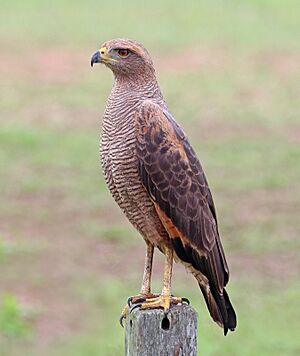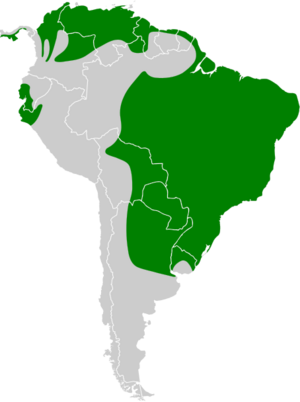Savanna hawk facts for kids
Quick facts for kids Savanna hawk |
|
|---|---|
 |
|
| In the Pantanal, Brazil | |
| Conservation status | |
| Scientific classification | |
| Genus: |
Buteogallus
|
| Species: |
meridionalis
|
 |
|
| Synonyms | |
|
Heterospizias meridionalis |
|
The savanna hawk (Buteogallus meridionalis) is a cool bird of prey, also known as a raptor. These birds are big and live in open grasslands called savannas. You can also find them near the edges of swamps. They live from Panama and Trinidad all the way south to Bolivia, Uruguay, and central Argentina.
What Does a Savanna Hawk Look Like?
Savanna hawks are about 46 to 61 centimeters (18 to 24 inches) long. They weigh around 845 grams (about 1.8 pounds). Adult savanna hawks have a reddish-brown body. Their upper parts have grey spots, and their belly has thin black stripes.
The long, wide feathers on their wings are black. Their tail has black and white stripes. Their legs are bright yellow. When they call, it sounds like a loud scream: keeeeru.
Young savanna hawks look a lot like the adults. However, their upper parts are darker and duller. Their underparts are lighter with thicker stripes. They also have a whitish stripe above their eyes. These birds often perch very straight up. Their legs are surprisingly long!
What Do Savanna Hawks Eat?
Savanna hawks are hunters. They eat many different things. Their diet includes small mammals, small birds, lizards, and snakes. They also enjoy toads, frogs, eels, and other fish.
Sometimes, they eat crabs, roots, spiders, and large insects like grasshoppers. A savanna hawk usually sits on a high spot where it can see everything. From there, it swoops down to catch its prey. They can also hunt by walking on the ground. Several hawks might even gather together to hunt near grass fires.
Savanna Hawk Reproduction
Savanna hawks build their nests from sticks. They line the inside with soft grass. These nests are usually built in a palm tree.
The female hawk lays only one white egg at a time. The young hawk stays in the nest for about 6.5 to 7.5 weeks. This is the time it takes for them to grow strong enough to fly, which is called fledging.



